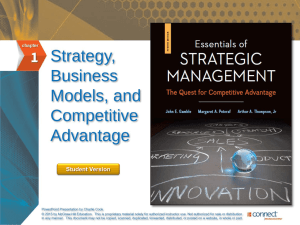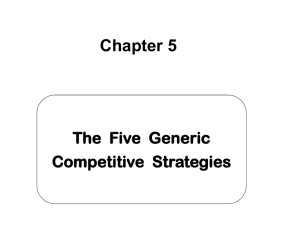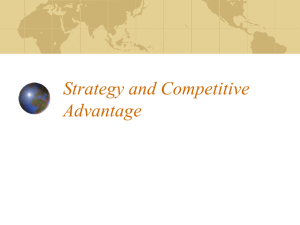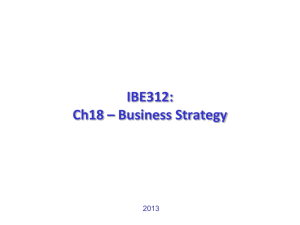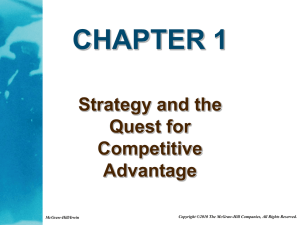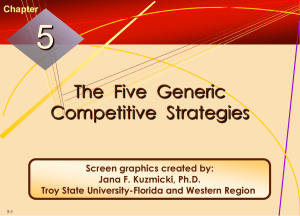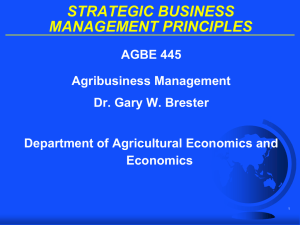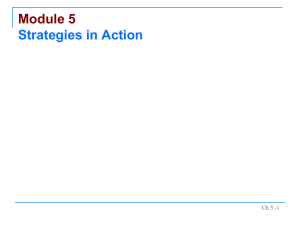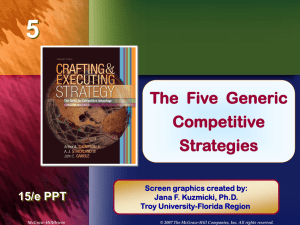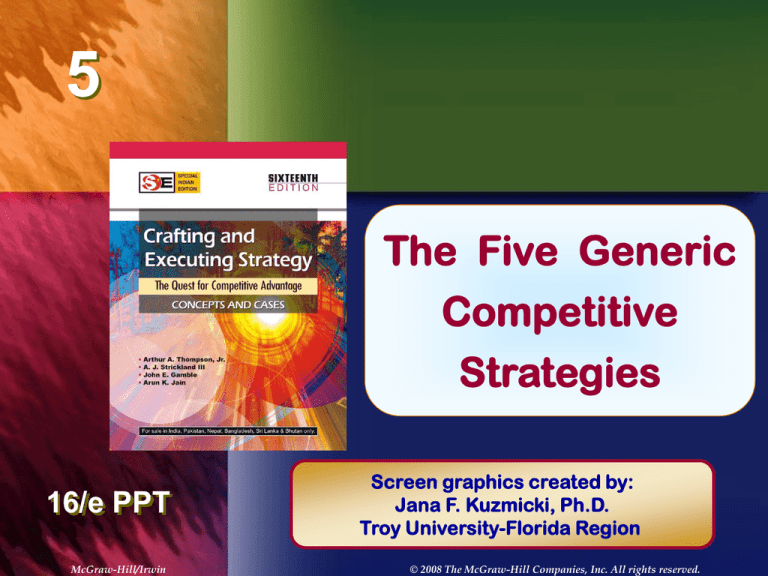
5
TheChapter
Five Generic
Title
Competitive
Strategies
16/e PPT
McGraw-Hill/Irwin
Screen graphics created by:
Jana F. Kuzmicki, Ph.D.
Troy University-Florida Region
© 2008 The McGraw-Hill Companies, Inc. All rights reserved.
Strategy and Competitive Advantage
advantage exists when a firm’s
strategy gives it an edge in
Competitive
Attracting customers and
Defending against competitive forces
Key to Gaining a Competitive Advantage
Convince
customers firm’s product / service offers
superior value
A good product at a low price
A superior product worth paying more for
A best-value product
5-2
Fig. 5.1: The Five Generic Competitive Strategies
5-3
Low-Cost Provider Strategies
Keys to Success
Make
achievement of meaningful lower costs
than rivals the theme of firm’s strategy
Include
features and services in product
offering that buyers consider essential
Find
approaches to achieve a cost advantage
in ways difficult for rivals to copy or match
Low-cost leadership means low overall costs, not
just low manufacturing or production costs!
5-4
Approaches to Securing
a Cost Advantage
Approach 1
Do a better job than rivals of
performing value chain activities
efficiently and cost effectively
Approach 2
Revamp value chain to bypass
cost-producing activities that add little
value from the buyer’s perspective
5-5
Control
costs!
By-pass
costs!
Keys to Success in Achieving
Low-Cost Leadership
Scrutinize each cost-creating activity, identifying cost drivers
Use knowledge about cost drivers to manage
costs of each activity down year after year
Find ways to restructure value chain to eliminate
nonessential work steps and low-value activities
Work diligently to create cost-conscious corporate cultures
Feature broad employee participation in continuous costimprovement efforts and limited perks for executives
Strive to operate with exceptionally small corporate staffs
Aggressively pursue investments in resources and
capabilities that promise to drive costs out of the business
5-6
Characteristics of a Low-Cost Provider
Cost
conscious corporate culture
Employee
participation in cost-control efforts
Ongoing
efforts to benchmark costs
Intensive
scrutiny of budget requests
Programs
promoting continuous cost improvement
Successful low-cost producers champion
frugality but wisely and aggressively
invest in cost-saving improvements !
5-7
When Does a Low-Cost
Strategy Work Best?
Price
competition is vigorous
Product is standardized or readily available
from many suppliers
There are few ways to achieve
differentiation that have value to buyers
Most buyers use product in same ways
Buyers incur low switching costs
Buyers are large and have
significant bargaining power
Industry newcomers use introductory low prices to
attract buyers and build customer base
5-8
Pitfalls of Low-Cost Strategies
Being
Low
overly aggressive in cutting price
cost methods are easily imitated by rivals
Becoming
too fixated on reducing costs
and ignoring
Buyer interest in additional features
Declining buyer sensitivity to price
Changes in how the product is used
Technological
breakthroughs open up cost
reductions for rivals
5-9
Differentiation Strategies
Objective
Incorporate
differentiating features that cause
buyers to prefer firm’s product or service over
brands of rivals
Keys to Success
Find
ways to differentiate that create value for
buyers and are not easily matched or cheaply
copied by rivals
Not
spending more to achieve differentiation
than the price premium that can be charged
5-10
Benefits of Successful Differentiation
A product / service with unique,
appealing attributes allows a firm to
Command a premium price and/or
Increase unit sales and/or
Build brand loyalty
Which
hat is
unique?
= Competitive Advantage
5-11
Types of Differentiation Themes
Unique taste – Dr. Pepper
Multiple features – Microsoft Windows and Office
Wide selection and one-stop shopping – Home Depot,
Amazon.com
Superior service -- FedEx, Ritz-Carlton
Spare parts availability – Caterpillar
Engineering design and performance – Mercedes, BMW
Prestige – Rolex
Product reliability – Johnson & Johnson
Quality manufacture – Karastan, Michelin, Toyota
Technological leadership – 3M Corporation
Top-of-line image – Ralph Lauren, Starbucks, Chanel
5-12
Where to Find Differentiation
Opportunities in the Value Chain
Purchasing
Product
and procurement activities
R&D and product design activities
Production
process / technology-related activities
Manufacturing
/ production activities
Distribution-related
Marketing,
Activities,
Costs, &
Margins of
Suppliers
activities
sales, and customer service activities
Internally
Performed
Activities,
Costs, &
Margins
Activities, Costs,
& Margins of
Forward Channel
Allies &
Strategic Partners
5-13
Buyer/User
Value
Chains
How to Achieve a
Differentiation-Based Advantage
Approach 1
Incorporate product features/attributes that
lower buyer’s overall costs of using product
Approach 2
Incorporate features/attributes that raise the
performance a buyer gets out of the product
Approach 3
Incorporate features/attributes that enhance buyer
satisfaction in non-economic or intangible ways
Approach 4
Compete on the basis of superior capabilities
5-14
When Does a Differentiation
Strategy Work Best?
There
are many ways to differentiate a product
that have value and please customers
Buyer
needs and uses are diverse
Few
rivals are following a similar
differentiation approach
Technological
change and
product innovation are fast-paced
5-15
Pitfalls of Differentiation Strategies
Appealing product features are easily copied by rivals
Buyers see little value in unique attributes of product
Overspending on efforts to differentiate the product
offering, thus eroding profitability
Over-differentiating such that product
features exceed buyers’ needs
Charging a price premium
buyers perceive is too high
Not striving to open up meaningful gaps in quality,
service, or performance features vis-à-vis rivals’
products
5-16
Best-Cost Provider Strategies
Combine
a strategic emphasis on low-cost with
a strategic emphasis on differentiation
Make an upscale product at a lower cost
Give customers more value for the money
Objectives
Deliver superior value by meeting or exceeding
buyer expectations on product attributes and
beating their price expectations
Be
the low-cost provider of a product with good-toexcellent product attributes, then use cost
advantage to underprice comparable brands
5-17
When Does a Best-Cost
Provider Strategy Work Best?
Where
buyer diversity makes
product differentiation the norm and
Where
many buyers are also
sensitive to price and value
5-18
Risk of a Best-Cost Provider Strategy
A best-cost
provider may get squeezed between
strategies of firms using low-cost and
differentiation strategies
Low-cost leaders may be able to siphon
customers away with a lower price
High-end differentiators may be able to
steal customers away with better product attributes
5-19
Focus / Niche Strategies
Involve
concentrated attention on a narrow piece of
the total market
Objective
Serve niche buyers better than rivals
Keys to Success
Choose
a market niche where buyers
have distinctive preferences, special
requirements, or unique needs
Develop
unique capabilities to serve
needs of target buyer segment
5-20
Approaches to Defining a Market Niche
Geographic
uniqueness
Specialized
requirements in
using product/service
Special
product attributes
appealing only to niche buyers
5-21
What Makes a Niche
Attractive for Focusing?
Big
enough to be profitable and offers good growth
potential
Not
crucial to success of industry leaders
Costly
or difficult for multi-segment competitors
to meet specialized needs of niche members
Focuser
has resources and capabilities
to effectively serve an attractive niche
Few
other rivals are specializing in same niche
Focuser
can defend against challengers via
superior ability to serve niche members
5-22
Risks of a Focus Strategy
Competitors
find effective ways to match
a focuser’s capabilities in serving niche
Niche
buyers’ preferences shift towards product
attributes desired by majority of buyers – niche
becomes part of overall market
Segment
becomes so attractive it becomes
crowded with rivals, causing segment profits to be
splintered
5-23
Deciding Which Generic
Competitive Strategy to Use
Each positions a company differently in its market and
competitive environment
Each establishes a central theme for how a company will
endeavor to outcompete rivals
Each creates some boundaries for maneuvering as market
circumstances unfold
Each points to different ways of experimenting with the
basics of the strategy
Each entails differences in product line, production
emphasis, marketing emphasis, and means to sustain the
strategy
The big risk – Selecting a “stuck in the middle” strategy!
This rarely produces a sustainable competitive
advantage or a distinctive competitive position!
5-24
5-25

